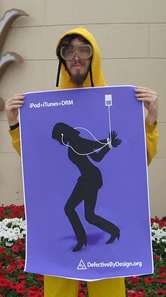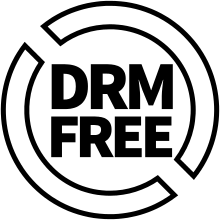Defective by Design
Defective by Design (DBD) is an anti-DRM initiative by the Free Software Foundation. DRM technology, known as "digital rights management" technology by its supporters, restricts users' ability to freely use their purchased movies, music, literature, software, and hardware in ways they are accustomed to with ordinary non-restricted media (such as books and audio compact discs). As a result, DRM has been described as "digital restrictions management" or "digital restrictions mechanisms" by opponents.[2][3][4][5][6]
Type of site | Grass-roots campaign |
|---|---|
| Available in | English |
| Owner | Unknown |
| Created by | Free Software Foundation |
| Revenue | No |
| URL | www |
| Alexa rank | |
| Commercial | No |
| Registration | No |
| Launched | May 2006 |
| Current status | Online |
Content license | CC BY-ND 3.0 |

The philosophy of the initiative is that DRM is designed to be deliberately defective, to restrict the use of the product. This, they claim, cripples the future of digital freedom. The group aims to target "Big Media, unhelpful manufacturers, and DRM distributors" and to bring public awareness of the issue and increase participation in the initiative. It represents one of the first efforts of the Free Software Foundation to find common cause with mainstream social activists, and to encourage free software advocates to become socially involved. As of late 2006, the campaign was claiming over 12,000 registered members.
View on the impact of DRM
DRM is used to encrypt various multimedia products (including audio, video, and console games) and is intended to restrict the uses of a product to those the rightsholders intend. Examples of DRM functionality include: limiting or prohibiting duplication of media to hopefully prevent copyright infringement or lawful archiving, sharing, of media and encrypting or blocking access to a system's input or output to prevent consumers from using non-licensed products, such as a competitor's hardware or media; DRM can prevent users from duplicating a CD or a DVD, prevent someone watching a DVD from skipping an advertisement, or create problems with interoperability between competing products. Although tech-savvy users are often able to find a way around DRM, this can be difficult and may require use of the analog hole. For others DRM might prevent them from using media in legal ways.[7]
In addition to restricting copying of DRM-restricted media, DRM can allow a computer to systematically disobey its owner.[8]
History
Defective By Design is a joint effort by the Free Software Foundation and CivicActions, a company that develops online advocacy campaigns. The chief organizers are Gregory Heller of CivicActions, Peter T. Brown, executive director of the Free Software Foundation, and Henry Poole, a CivicActions member who is also a director of the Free Software Foundation.
The campaign was launched in May 2006, with an anti-DRM protest at WinHEC. The protest featured Free Software Foundation (FSF) members in yellow hazmat suits "handing out pamphlets explaining that Microsoft products are – in the words of the key slogan for the campaign – 'defective by design' because of the DRM technologies included in them".[9]
Since then, the campaign has launched a number of actions with varying degrees of success. The campaign claims that its phone-in campaign against the Recording Industry Association of America[10] and related organizations around the world resulted in thousands of calls from people questioning the industry's position on DRM. On the other hand, efforts to meet with Bono of U2, a prominent supporter of Apple's DRM-regulated iTunes, have so far met with no success. However, four major record labels dropped their pending lawsuits and joined with Apple and Microsoft to eliminate Digital Rights Management from music sales.
DefectiveByDesign.org proclaimed October 3, 2006, to be a "Day Against DRM", and organized several events outside key Apple stores in the US and the UK.[11] Again hazmat suits were worn by protesters and leaflets were handed out to the public explaining Apple's use of DRM in their iTunes music store and on their iPod media players.[12]
On January 30, 2007, the campaign organized along with the BadVista campaign at the Times Square. Protesters in hazmat suits then handed literature to attendants about the dangers of Windows Vista's Digital Rights Management and Trusted Computing features, as well as handed over CDs with free software for users to install an alternative to Windows Vista.[13]
Tagging campaign

The Defective by Design site encourages users to use the tagging feature of Amazon.com, Slashdot and on other sites that allow tagging, to mark certain products with the 'defectivebydesign' tag.[14] Items targeted include DVD players, DRM-restricted DVD titles, HD DVD and Blu-ray Disc titles, Windows XP and higher, the Zune, and the iPod.
See also
| Wikimedia Commons has media related to Defective by Design. |
References
- "alexa.com Competitive Analysis, Marketing Mix and Traffic - Alexa". www.alexa.com. Retrieved 12 August 2020.
- Digital Restrictions Management. DRM.info. Retrieved on 2013-07-29.
- What is DRM?. Defective by Design. Retrieved on 2013-07-29.
- GNU Art – Digital Restrictions Management – GNU Project – Free Software Foundation. Gnu.org (2013-02-28). Retrieved on 2013-07-29.
- Rick Falkvinge (14 July 2013). "Language Matters: Framing The Copyright Monopoly So We Can Keep Our Liberties". torrentfreak.com. Archived from the original on 4 June 2014. Retrieved 17 August 2014.
- "Apple's Operating Systems Are Malware". gnu.org. Archived from the original on 16 July 2014. Retrieved 9 November 2014.
- The Escapist : News : Ubisoft DRM Authentication Servers Go Down. Escapistmagazine.com. Retrieved on 2013-07-29.
- Doctorow, Cory (2008-01-22). "Apple cripples debugging tool to keep iTunes DRM safe". Retrieved 2008-01-29.
- Bruce Byfield (May 23, 2006). "FSF launches anti-DRM campaign outside WinHEC 2006". NewsForge. Archived from the original on 2015-07-06. Retrieved 2007-04-18.
- "Freedom Rings The RIAA" Check
|url=value (help). Retrieved 2008-01-21. - PeterB (August 31, 2006). "October 3rd Declared "Day Against DRM"". defectivebydesign.org. Retrieved 2007-04-18.
- Nate Anderson (October 3, 2006). "Welcome to "Day Against DRM"". Ars Technica, LLC. Retrieved 2007-04-18.
- John Sullivan (January 30, 2007). "A BadVista at Microsoft's New York launch parties". BadVista.org. Retrieved 2008-01-12.
- "Amazon Product Tagging Campaign". defectivebydesign.org. Retrieved 2007-04-24.
External links
- Official website

- Stallman, Richard (Nov 18, 2016). "Can you trust your computer?". Essay.